Study on Critical Width of Semi-Coal Rock Roadway of Shallow-Buried Thin Coal Seam Based on Coal Side Self-Stabilization
Abstract
1. Introduction
2. Project Profile
3. Shallow-Buried Thin-Coal-Seam Semi-Coal Rock Roadway-Surrounding Rock Stability Analysis
3.1. Analysis of Mechanical Properties of Layered Roof in Semi-Coal Rock Roadway of Shallow Thin Coal Seam
3.2. Analysis of Influencing Factors of Critical Width under Self-Stabilization Condition of Coal Side
4. Field Test Verification of Loose Circle
4.1. Loose Circle Test Equipment
4.2. Station Layout
4.3. Analysis of Measured Results
5. Optimization of Support Scheme
5.1. Supporting Scheme Correction and Parameters
5.2. Numerical Model and Simulation Scheme
5.3. Simulation Results and Analysis
6. Engineering Application Effect
7. Conclusions
- (1)
- Based on the structural characteristics of the layered roof of the transportation roadway in the 2107 working face of Anzhe Coal Mine, the roof is analyzed as an infinitely long plate, and the mechanical model of the layered roof of the semi-coal rock roadway in the shallowly buried thin coal seam is established. By analyzing the interaction between the fractured coal of the two sides and the roof, the calculation formula of the critical width of the semi-coal rock roadway in the shallow-buried thin coal seam is given to determine the stability of the two sides. The critical width of the semi-coal rock roadway in the shallow thin coal seam is defined as the maximum excavation width of the roadway where the coal sides can maintain self-stability without support. The thickness of the coal loose circle of the two sides increases with the increase in thickness of the coal seam. When the thickness is increased to a certain extent, the surrounding rock is unstable, and the critical width of the semi-coal rock roadway in shallow-buried thin coal seam does not exist.
- (2)
- By establishing the calculation model of the interface stress of the coal of the two sides, the expression of the thickness of the coal loose circle of the two sides is derived, and the theoretical thickness of the coal loose circle of the two sides of the 2107 working face is 0.64 m. Through case analysis, the calculation formula of the critical width of the semi-coal rock roadway in the shallow-buried thin coal seam has good applicability to typical shallow-buried mine roadways in the Niuwu mining area and shallow-buried semi-coal rock roadways with coal thickness below 0.7 m under similar geological conditions. The critical width under the condition of self-stability of the coal sides is mainly related to the three parameters of the tensile strength of the roof, the buried depth of the roadway, and the thickness of the immediate roof strata. The degree of influence of each parameter is: thickness of the immediate roof strata > tensile strength of the roof > buried depth of the roadway.
- (3)
- The loose circle of surrounding rock is measured on the coal and rock mass of the two sides of the roadway. The thickness of the rock mass loose circle of the two sides is 0.2 m, and the thickness of the coal loose circle of the two sides is 0.6–0.7 m. The measured values were consistent with the theoretical calculation results. The thickness of the loose circle of the two sides is based on the coal, and the maximum thickness of the coal loose circle of the two sides is 0.7 m. After calculation, the actual width of the roadway is 2.4 m, less than the critical width of 2.9 m, and the two sides of the roadway can maintain self-stability without support.
- (4)
- Based on the theory of surrounding rock loose circle support and critical width analysis, the support scheme is optimized, and its safety and rationality are verified by numerical simulation. The plastic zone of the roof is 0.4 m, the plastic zone of the two sides is 0.6 m, the convergence of the roof and floor is 45.68 mm, and the convergence of the two sides is 19.25 mm, which is not much different from the original support effect. The field engineering application shows that the period of influence of roadway excavation is about 25 days, the maximum convergence of the roof and floor is 46.3 mm, and the maximum convergence of the two sides is 18.4 mm. The optimized support scheme still effectively controls the deformation of the roadway-surrounding rock and can meet the requirements of safe production.
Author Contributions
Funding
Institutional Review Board Statement
Informed Consent Statement
Data Availability Statement
Conflicts of Interest
References
- Ren, B.; Ding, K.; Wang, L.G.; Jiang, C.Y.; Guo, J.X. Research on an Intelligent Mining Complete System of a Fully Mechanized Mining Face in Thin Coal Seam. Sensors 2023, 23, 9034. [Google Scholar] [CrossRef] [PubMed]
- Huang, Q.X.; He, Y.P.; Cao, J. Experimental Investigation on Crack Development Characteristics in Shallow Coal Seam Mining in China. Energies 2019, 12, 1302. [Google Scholar] [CrossRef]
- Huang, Q.X.; He, Y.P. Research on Overburden Movement Characteristics of Large Mining Height Working Face in Shallow Buried Thin Bedrock. Energies 2019, 12, 4208. [Google Scholar] [CrossRef]
- Huang, Q.X.; Zhou, J.L.; Mang, L.T.; Tang, P.F. Double key strata structure analysis of large mining height longwall face in nearly shallow coal seam. J. China Coal Soc. 2017, 42, 2504–2510. [Google Scholar]
- Wang, M.; Xiao, T.Q.; Gao, J.; Liu, J.L. Deformation mechanism and control technology for semi coal and rock roadway with structural plane under shearing force. J. Min. Saf. Eng. 2017, 34, 527–534. [Google Scholar]
- Li, C.Z. Study on surrounding rock deformation and control technology of mining roadway in shallow coal seam. Coal Chem. Ind. 2022, 45, 40–45. [Google Scholar]
- Han, C.; Yuan, Y.; Ding, G.; Li, W.; Yang, H.; Han, G. The Active Roof Supporting Technique of a Double-Layer Flexible and Thick Anchorage for Deep Withdrawal Roadway under Strong Mining Disturbance. Appl. Sci. 2023, 13, 12656. [Google Scholar] [CrossRef]
- Wang, X.J.; Tang, J.Z.; Li, Y.M.; Fu, Q. The Failure Law and Combined Support Technology of Roadways with Weak Surrounding Rock in Deep Wells. Appl. Sci. 2023, 13, 9738. [Google Scholar] [CrossRef]
- Wei, X.; Shahani, N.M.; Zheng, X.; Wang, J.; Wang, Y.; Chen, C.; Ren, Z. The Retention and Control Technology for Rock Beams in the Roof of the Roadway: A Case Study. Processes 2023, 11, 1593. [Google Scholar] [CrossRef]
- Liu, C.; Wang, F.T.; Zhang, Z.Y.; Zhu, D.X.; Hao, W.H.; Tan, T.K.; Zhang, X.T.; Zhu, C.G. Surrounding Rock Deformation Mechanism and Control Technology for the Roadway in the Fault-Disturbed Zone under Special-Shaped Coal Pillars. Processes 2023, 11, 3264. [Google Scholar] [CrossRef]
- Zhu, R.J.; Yue, X.Z.; Gao, Y.D.; Liu, X.S.; Li, X.B.; Xie, C.C.; Wang, K. Study on the Stress Evolution and Strengthening Support Timing of the Retracement Channel under the Super-Thick Nappe. Sustainability 2023, 15, 15677. [Google Scholar] [CrossRef]
- Jin, G.; Wang, L.G.; Li, Z.L.; Zhang, J.H. Study on the gateway rock failure mechanism and supporting practice of half-coal-rock extraction roadway in deep coal mine. J. Min. Saf. Eng. 2015, 32, 963–967. [Google Scholar]
- Yue, W.J.; Feng, T.; Wang, W.J.; Liu, H.; Ma, P.Y.; Wang, P.; Li, R.H. Deformation mechanism control principle and technology of soft half coal rock roadway. Chin. J. Rock. Mech. Eng. 2014, 33, 658–671. [Google Scholar]
- Wang, J.X.; Sheng, J.; Chen, Z.H. Study into Damage Mechanics of Anchoring Reinforced Roadway in Jointed Coa l Rock Mass. J. Min. Saf. Eng. 2009, 26, 203–207. [Google Scholar]
- Duo, S.H.; Yue, W.J.; Zhang, T.L.; Zhao, J.F. Deformation mechanism and support technology of soft and extremely fractured coal-rock roadway with large deformation. Coal Sci. Technol. 2016, 44, 15–21. [Google Scholar]
- Yan, D.H.; Cheng, Z.H.; Liu, Y.; Jiang, X.Q.; Du, Z.F.; Yao, J.G. Study on bolt support technology of semi coal rock roadway in Shaqu Mine. Coal Sci. Technol. 2020, 48 (Suppl. S1), 12–17. [Google Scholar]
- Wang, H.; Li, Y.C.; Zhao, W.J. Excavation stability analysis and support parameter evaluation of semi-coal rock roadway. Saf. Coal Mines 2008, 11, 56–59. [Google Scholar]
- Li, J.F.; Guo, W.Y.; Zhang, C.L.; Cheng, C.X.; Liu, J.K.; Zhou, G.L. Supporting Technology of Fully Mechanized Half-coal Rock Mining Roadway in Thin Seam. Saf. Coal Mines 2013, 44, 97–103. [Google Scholar]
- Qiu, W.H.; Kong, L.H.; Zhao, S.K.; Zhang, S.X.; Wang, H.M. Failure Characteristics and Control of Surrounding Strata of Coal and Rock Roadway. Saf. Coal Mines 2017, 48, 202–205. [Google Scholar]
- Cui, Q.L.; Wu, J.X. Parameters Optimization of Bolting in Mining Coal-Rock Roadway Under Shallow Overburden. Coal Eng. 2015, 47, 48–50. [Google Scholar]
- Li, Z.L.; Wang, L.G.; Lu, Y.L.; Li, W.S.; Wang, K. Effect of principal stress rotation on the stability of a roadway constructed in half-coal-rock stratum and its control technology. Arab. J. Geosci. 2021, 14, 292. [Google Scholar] [CrossRef]
- Wang, H.; Jiang, C.; Zheng, P.Q.; Zhao, W.J.; Li, N. A combined supporting system based on filled-wall method for semi coal-rock roadways with large deformations. Tunn. Undergr. Space Technol. Inc. Trenchless Technol. Res. 2020, 99, 103382. [Google Scholar] [CrossRef]
- Wang, E.Y.; Chen, X.D.; Yang, X.J. Research and Application of an Innovative 110 Mining Method in Gob-Side Half Coal Rock Entry Retaining. Shock. Vib. 2021, 2021, 8228604. [Google Scholar] [CrossRef]
- Pan, B.; Yue, W.J.; Shen, W.B. Experimental Study on Energy Evolution and Failure Characteristics of Rock–Coal–Rock Combination with Different Height Ratios. Geotech. Geol. Eng. 2020, 39, 425–435. [Google Scholar] [CrossRef]
- Huang, Q.X.; Zheng, C. Theory of self-stable ring in roadway support. Rock. Soil. Mech. 2016, 37, 1231–1236. [Google Scholar]
- Wang, H.S.; Zhang, D.S.; Li, S.G.; Wang, L.; Wu, L.Z. Rational width of narrow coal pillar based on the fracture line location of key rock B in main roof. J. Min. Saf. Eng. 2014, 31, 10–16. [Google Scholar]
- Wang, B.; Wang, W.J.; Zhao, F.J.; Fan, B.J.; Tang, H.X. Study of bolt anchoring effect based on self-bearing characteristics of roadway surrounding rock. Rock. Soil. Mech. 2014, 35, 1965–1972. [Google Scholar]
- Li, L.; Bai, J.B.; Xu, Y.; Xiao, T.Q.; Wang, X.Y.; Zhang, K.X. Research on rock control of roadway with complex roof driven along goaf. J. Min. Saf. Eng. 2011, 28, 376–383. [Google Scholar]
- Bai, J.B.; Hou, C.J. On bolting support of roadway in extremely soft seam of coal mine with complex roof. J. Rock. Mech. Geotech. Eng. 2001, 1, 53–56. [Google Scholar]
- Qian, M.G.; Shi, P.W.; Xu, J.L. Ground Pressure and Strata Control, 2nd ed.; China University of Mining and Technology Press: Beijing, China, 2015; pp. 75–76. [Google Scholar]
- Wang, Z.X.; Hou, K.P.; Sun, H.F. Study on limit span of roadway. China Min. Mag. 2023, 32, 112–117. [Google Scholar]
- Liu, Y.T.; Han, Q.Q.; Pang, T.; He, H.D.; Zhang, S.J. Equalizing Reinforcement Support Design and Application in Stratified Roof Roadway. Saf. Coal Mines 2014, 45, 139–141. [Google Scholar]
- Song, H.W.; Guo, Z.H.; Zhou, R.Z.; Dong, F.T.; Zhang, S.J. The basic viewpoint of roadway support theory in a loose circle of surrounding rock. Mine Constr. Technol. 1994, 45, 3–9. [Google Scholar]
- Hou, C.J.; Ma, N.J. Discussion on stress and limit equilibrium zone of coal body in two gangs of coal seam roadway. J. China Coal Soc. 1989, 4, 21–29. [Google Scholar]
- Gao, S.G.; Gao, D.Y.; OuYang, Y.B.; Chai, J.; Zhang, D.D.; Ren, W.Q. Intelligent mining technology and its equipment for medium thickness thin seam. J. China Coal Soc. 2020, 45, 1997–2007. [Google Scholar]
- Yu, Y.X.; Hong, X.; Chen, F.F. Study on load transmission mechanism and limit equilibrium zone of coal-wall in extraction opening. J. China Coal Soc. 2012, 37, 1630–1636. [Google Scholar]
- Guo, Z.H.; Dong, F.T. Surrounding rock loose circle and roadway support. J. Min. Saf. Eng. 1995, Z1, 111–114. [Google Scholar]
- Dong, F.T.; Song, H.W.; Guo, Z.H.; Lu, S.M.; Liang, S.J. Support theory of roadway surrounding rock loose circle. J. China Coal Soc. 1994, 1, 21–32. [Google Scholar]
- State Administration of Work Safety. Coal Mine Safety Regulations; Coal Industry Press: Beijing, China, 2022. [Google Scholar]
- Pu, L.; Liu, Y.J.; Cai, Y.B.; Sun, Z.; Zhou, X. Study on Active Support Parameters for Surrounding Rock with Ultra-Large Span Open-Off Cut in Thick Coal Seam. Appl. Sci. 2023, 13, 12804. [Google Scholar] [CrossRef]
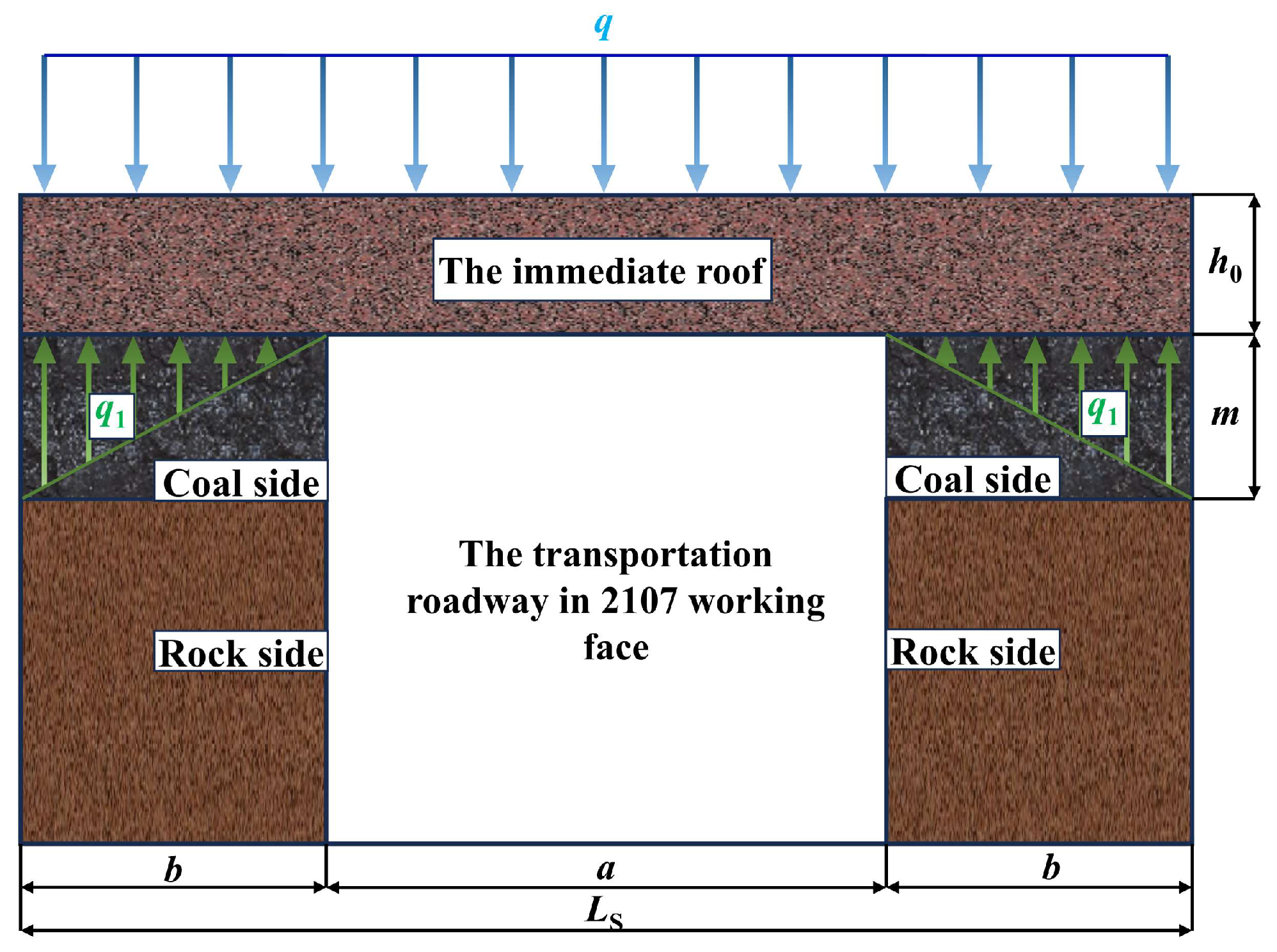


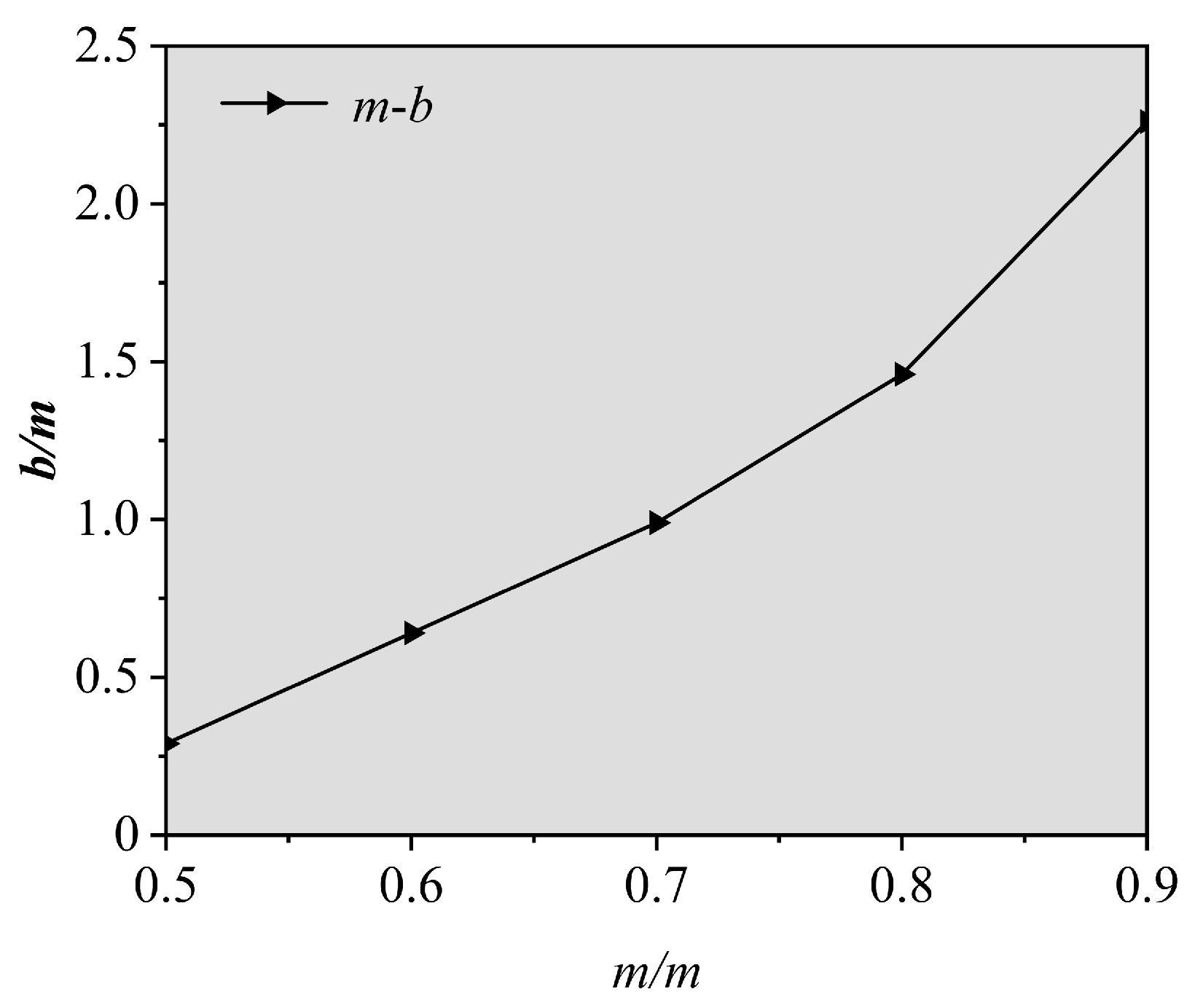



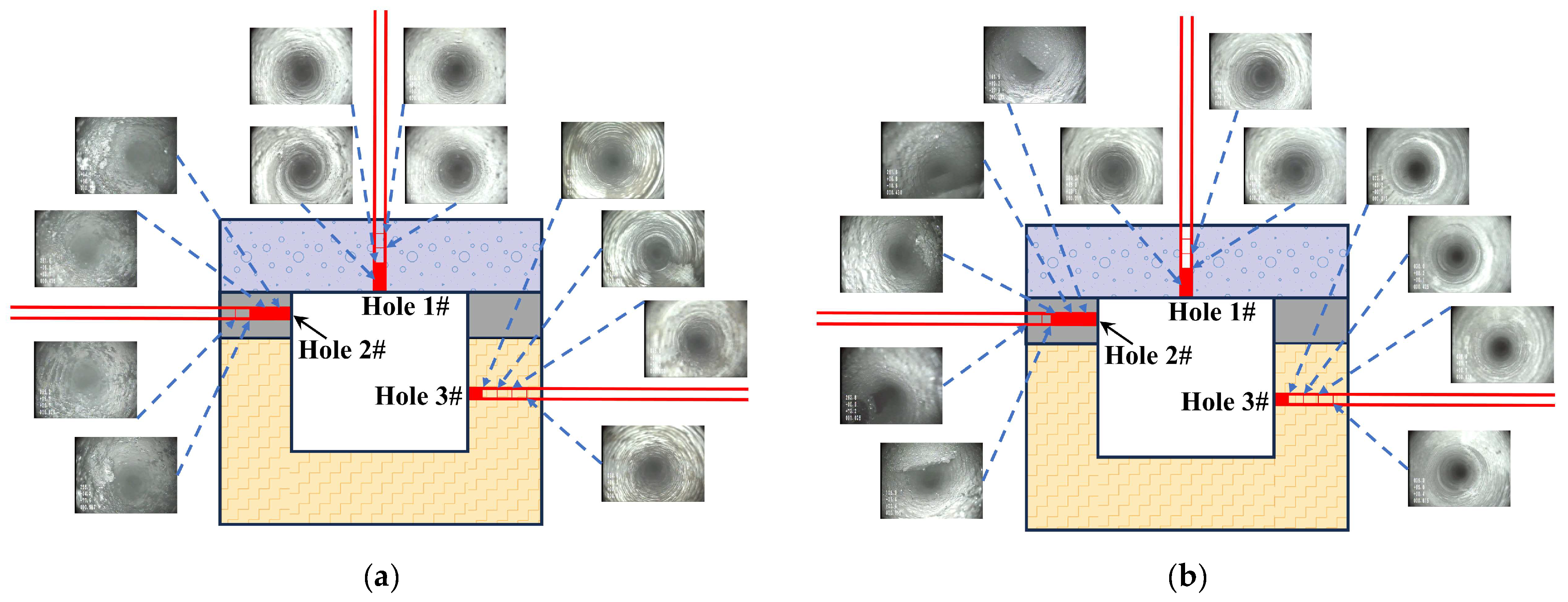


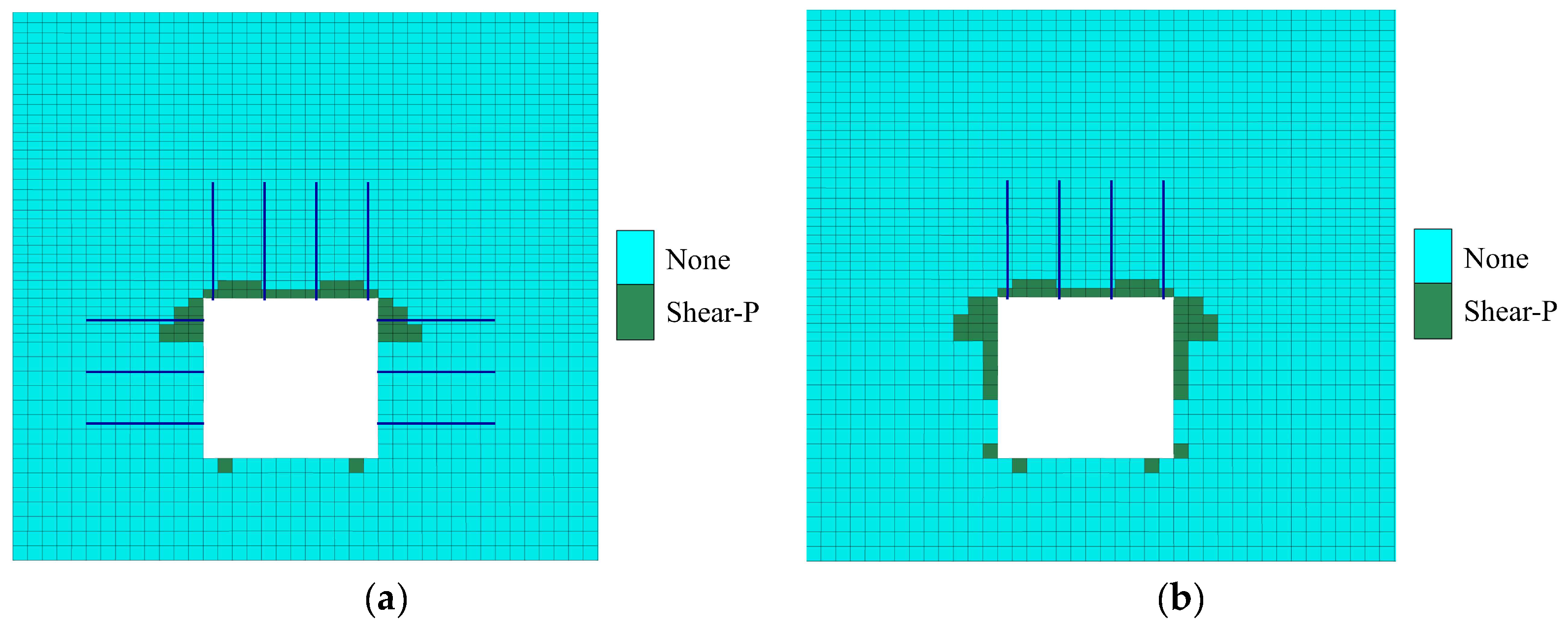
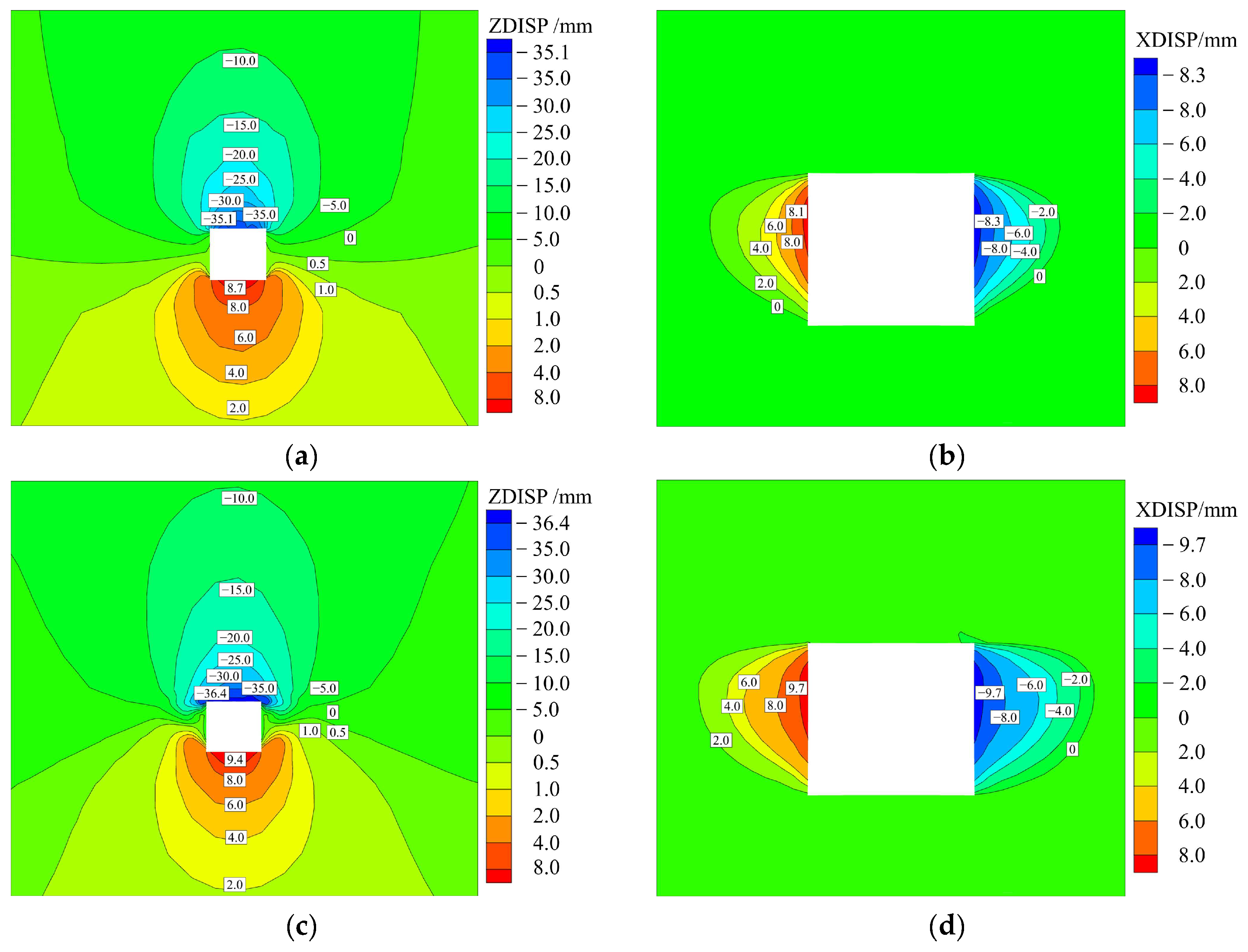
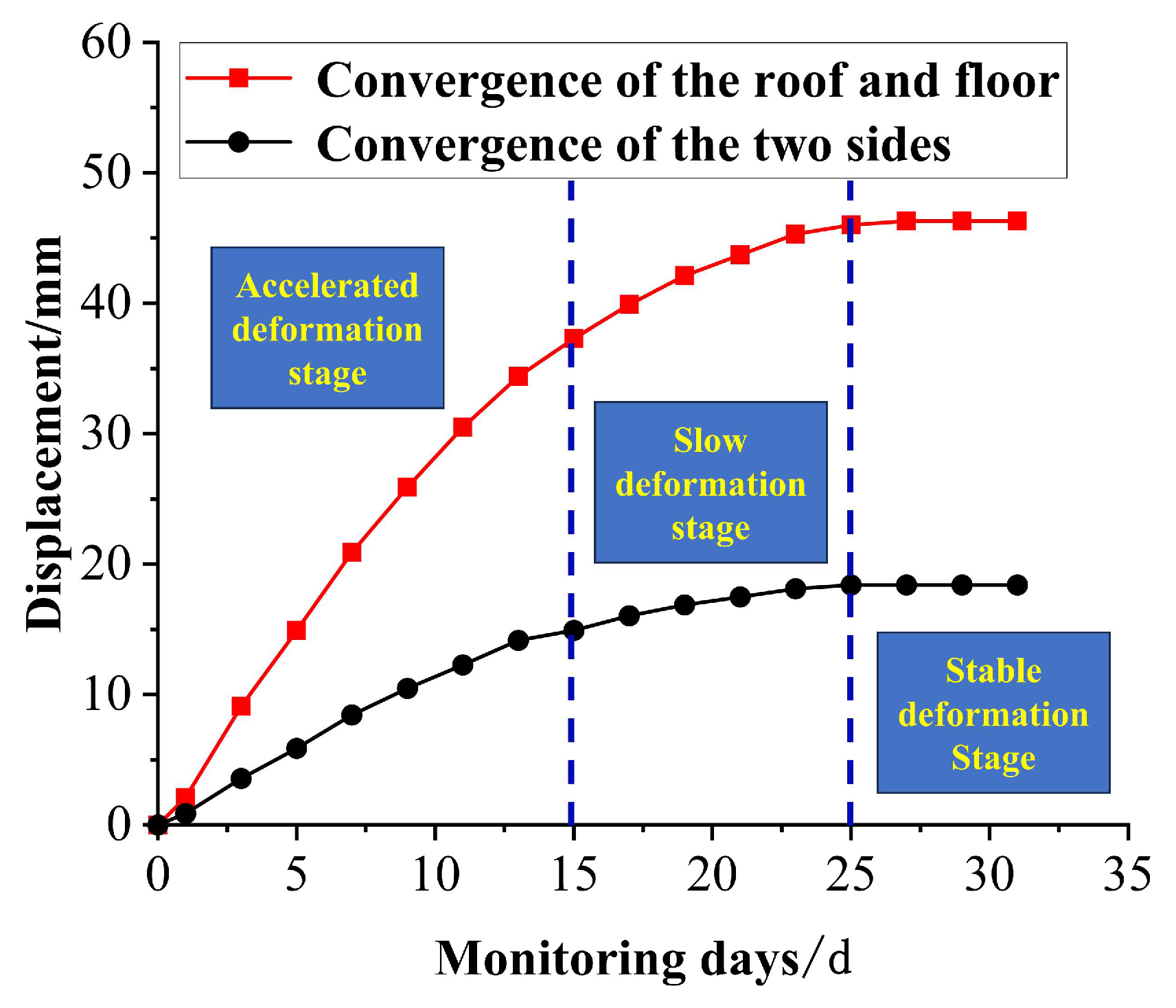
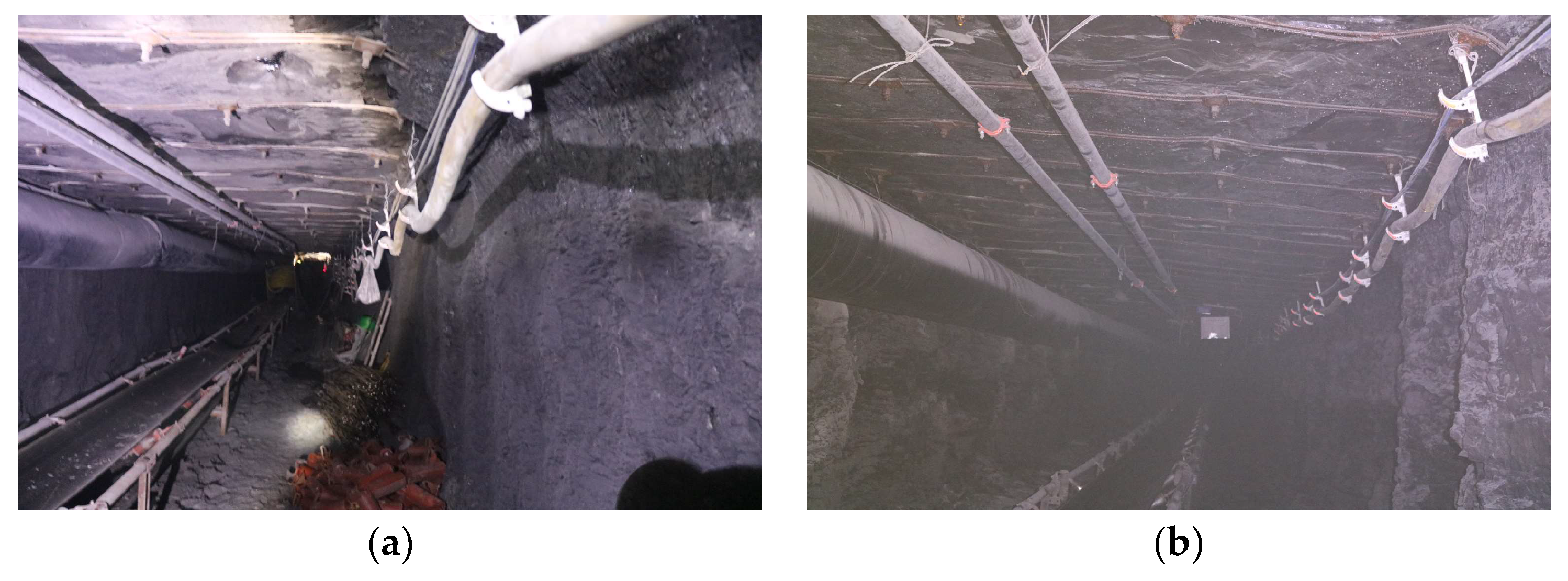
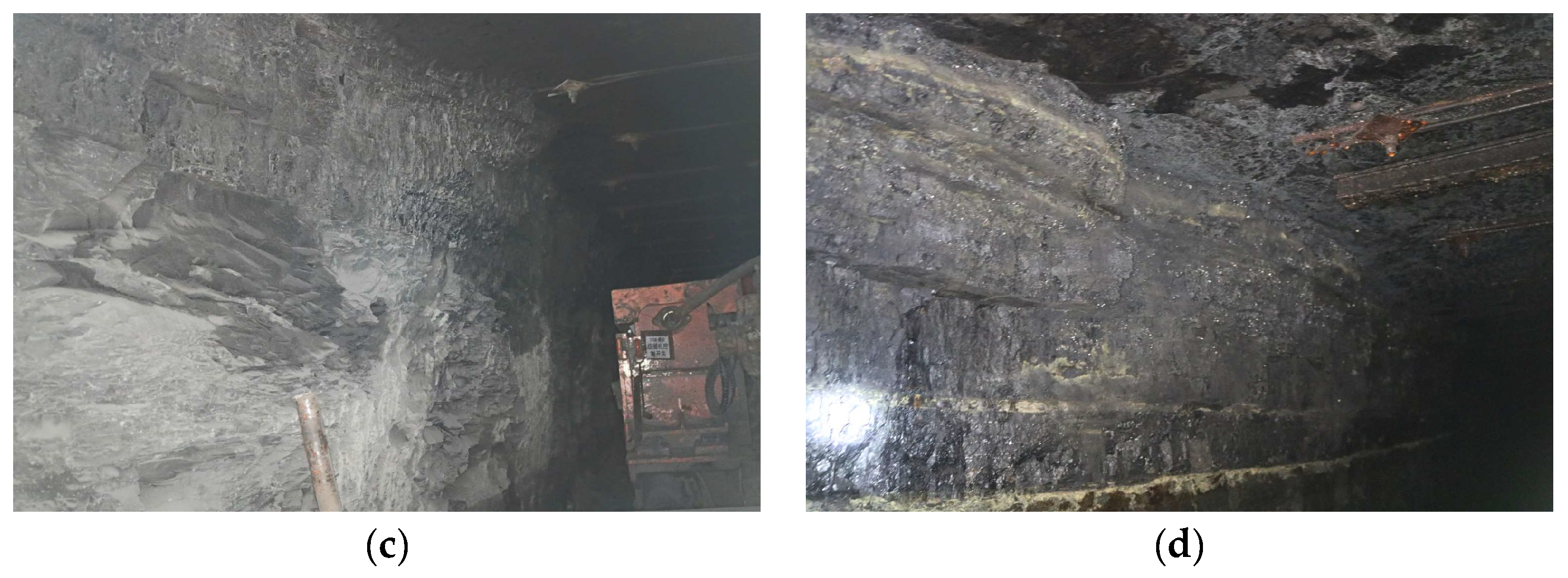
| Rock Formation | Elastic Modulus/GPa | Poisson Ratio | Internal Friction Angle/(°) | Cohesion/MPa | Tensile Strength/MPa | Density /kg·m−3 |
|---|---|---|---|---|---|---|
| Fine-grained sandstone | 16.67 | 0.17 | 38.19 | 17.90 | 4.22 | 2500 |
| Medium-grained sandstone | 16.55 | 0.19 | 40.32 | 16.13 | 8.44 | 2400 |
| Mudstone | 3.12 | 0.18 | 36.00 | 2.85 | 1.36 | 2230 |
| Siltstone | 19.22 | 0.14 | 36.60 | 12.25 | 3.36 | 2600 |
| Sandy mudstone | 8.42 | 0.12 | 32.40 | 6.89 | 2.78 | 2460 |
| Coal seam | 2.36 | 0.11 | 35.19 | 2.27 | 0.88 | 1350 |
| Fine-grained sandstone | 16.67 | 0.17 | 38.19 | 17.90 | 4.22 | 2500 |
| Medium-grained sandstone | 16.55 | 0.19 | 40.32 | 16.13 | 8.44 | 2400 |
| Station | Bore Hole | Thickness of Loose Circle | Surrounding Rock Classification | Lithology of Surrounding Rock |
|---|---|---|---|---|
| P 1 | Hole 1 | 0.4 m | Ⅰ | Stabilizing surrounding rock |
| Hole 2 | 0.6 m | Ⅱ | Relatively stable surrounding rock | |
| Hole 3 | 0.2 m | Ⅰ | Stabilizing surrounding rock | |
| P 2 | Hole 1 | 0.2 m | Ⅰ | Stabilizing surrounding rock |
| Hole 2 | 0.7 m | Ⅱ | Relatively stable surrounding rock | |
| Hole 3 | 0.2 m | Ⅰ | Stabilizing surrounding rock |
| Scheme | Roof Subsidence /mm | Floor Heave /mm | Left Side /mm | Right Side /mm |
|---|---|---|---|---|
| Original support | 35.09 | 8.65 | 8.07 | 8.21 |
| Optimized support | 36.37 | 9.31 | 9.61 | 9.64 |
Disclaimer/Publisher’s Note: The statements, opinions and data contained in all publications are solely those of the individual author(s) and contributor(s) and not of MDPI and/or the editor(s). MDPI and/or the editor(s) disclaim responsibility for any injury to people or property resulting from any ideas, methods, instructions or products referred to in the content. |
© 2024 by the authors. Licensee MDPI, Basel, Switzerland. This article is an open access article distributed under the terms and conditions of the Creative Commons Attribution (CC BY) license (https://creativecommons.org/licenses/by/4.0/).
Share and Cite
Wang, H.; Liu, Y.; Li, L.; Yue, G.; Jia, L. Study on Critical Width of Semi-Coal Rock Roadway of Shallow-Buried Thin Coal Seam Based on Coal Side Self-Stabilization. Sustainability 2024, 16, 5689. https://doi.org/10.3390/su16135689
Wang H, Liu Y, Li L, Yue G, Jia L. Study on Critical Width of Semi-Coal Rock Roadway of Shallow-Buried Thin Coal Seam Based on Coal Side Self-Stabilization. Sustainability. 2024; 16(13):5689. https://doi.org/10.3390/su16135689
Chicago/Turabian StyleWang, Hongsheng, Yi Liu, Lei Li, Guixiang Yue, and Lei Jia. 2024. "Study on Critical Width of Semi-Coal Rock Roadway of Shallow-Buried Thin Coal Seam Based on Coal Side Self-Stabilization" Sustainability 16, no. 13: 5689. https://doi.org/10.3390/su16135689
APA StyleWang, H., Liu, Y., Li, L., Yue, G., & Jia, L. (2024). Study on Critical Width of Semi-Coal Rock Roadway of Shallow-Buried Thin Coal Seam Based on Coal Side Self-Stabilization. Sustainability, 16(13), 5689. https://doi.org/10.3390/su16135689





